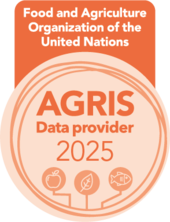Stock status of Hepsetus odoe (Bloch 1974) in river Imo, Nigeria, for conservation and management strategies for sustainability
DOI:
https://doi.org/10.57188/manglar.2025.031Keywords:
Hepsetus odoe, Imo River, Exploitation, Conservation, Sustainable Yield, StrategiesAbstract
The fisheries stock status: growth, recruitment rates, Maximum Sustainable Yield (MSY), Mortality and Exploitation rate of Hepsetus odoe in river Imo, Nigeria were investigated. Assorted fishing gears with mesh sizes (15 – 30 mm) were used to catch fish in designated 4 sampling stations of River Imo from January to July 2023. Standard lengths (S.L.) of 131,226 specimens of H. odoe were taken to the nearest centimeter (cm) and analyzed with Electronic Length Frequency Analysis (ELEFAN II) then fitted into the Von Bertalanffy Growth Model (VBGM). The estimated VBGM was L(t) = 55.65[1 – e -0.24(t – 0.9)]. The estimated growth parameters value was for L∞ = 55.65 cm; Total Mortality (Z) = 1.21 yr-1, Natural Mortality (M) = 0.52 yr-1, Fishing Mortality (F) = 0.69 yr-1 and Exploitation rate (E) = 0.57 yr-1. H. odoe was slightly over-exploited in River Imo, being that estimated Exploitation maximum (Emax) was 0.52 yr-1. The Relative Yield per Recruitment (Y’/R) indicates that the fishery is not operating at its MSY. The Reproductive load indicated over-fishing. There should be restrictions on the mesh sizes in use and closed fishing season of H. odoe in the identified recruitment peak of the month of June, every year to avoid the collapse of the species’ fishery in River Imo which may threaten the current conservation status of the species by International Union for Conservation of Nature (IUCN).
Downloads
References
REFERENCES
Abobi S. M., & Ekan, W. (2013). Exploitation Rates of some Fish species in Zawon Reservior. J. Gf. Sc. And Tech, 16(2), 153–161.
Adesulu, E. A., & Sydenham, D. H. J. (2002). The Freshwater and Fisheries of Nigeria. Macmillan Nigeria Publishers, Lagos, Nigeria 397 pp.
Afigbo, A. E. (2005). Toyin Falola (ed.) Nigerian History, Politics and affairs. The collected essays of Adiele Afigbo. Africa World Press. P.95 ISBN 1-59221-324-3.
Awugo, V., & Igejongbo, T. F. (2024). Determination of heavy metals concentration in African Pike H. Odoe from Alope River Southwestern, Nigeria. Marine Development, 2, 18. https://doi.org/10.1007/s44312-024-00030-5
Beyer, J. E. (2009). On length-weight relationships Part I: Computing the mean weight of the fish in a given length class. Fishbyte, April 1987: 11-13.
Charles, K., & Favour, E. (2013). Introduction to Hepsetus species (Characiformes – Hepsetidae). J. Aqua. Sc., 41(2), 132 – 138.
Conquest, L., Buss, R., Donnelly, J., Chavarria, J., & Gallucci, V. (2015). Sampling methods for stock assessment of small scale fisheries in developing countries p. 179 -225. In: V. F. Gallucci, S. B., Salia D. J. Gustatson and B. J. Rothschild (Eds.) Stock Assessment Quantitative Methods and Applications for Small Scale Fisheries. CRC Press, New York, NY.
Decru, E., Vreven, E., & Snoeks, J. (2013). A revision of the Lower Guinean Hepsetus species (Characiformes: Hepsetidae) with the description of H. Kingsleyae sp. nov. J. Fis. Bio., 82(4), 1351–1375. https://doi.org/10.1111/jfb.12079
FAO (2011). Food and Agriculture Organization. Review of the state of World Marine Fishery Resources which discusses MSY and its application in global Fisheries. FAO Tech. pap. 569
Froese, R. (2006). Cube Law, condition factor and weight-length relationships, history, meta-analysis and recommendations. Journal of Applied Ichthyology, 22(4), 241-253. https://doi.org/10.1111/j.1439-0426.2006.00805.x
Gallagher, R. (2013). Recruitment over-fishing in Lake Pigya. P. 195-239. In: D. Pauly and G.I. Murphy (eds). Theory and management of Tropical Fisheries. ICLARM conf. proc. No. 7. Manila.
Gayanilo, F. C., Sparre, P., & Pauly, D. (2005). FAO-ICLARM Stock Assessment Tools II (FISAT II) User’s guide FAO Computerized Information series (Fisheries). No 8, revised version, FAO, Rome, 168 pp.
Hilborn, R., & Walters, C. J. (2013). Quantitative Fisheries stock Assessment. Published by Springer New York NY. eBook ISBN 978-1-4615-3598-0. https://doi.org/10.1007/978-1-4615-3598-0
Hoggarth, D. D., Abeyasekera, S., Arthur, A., Beddington, J. R., Burn, R. W., Halls, A. S., Kirkwood, G. P., McAllister M., Medley P., Mees, C. C., Pilling G. M., Wakeford, R., & Welcomme, R. L. (2006). Stock assessment and Fishery management. A framework guide to the FMSP stock assessment tools. FAO Fisheries Technical Paper No. 487, Rome, Italy 261 pp. 17.
Hossain, Y, Admassu, D., & Mengistou, S. (2009). Exploitation of Oreochromis niloticus in Lake Chamo, Ethiopia. SINET: Eth J. Sci., 23(1), 1 – 12.
Idowu, E. O. (2023). Studies on Age and Growth of Aftrican Pike H. Odoe in Ado Ekiti Reservoir. IOSR Journal of Pharmacy and Biological Sciences (IOSR – JPBS), 8(3), 75–82.
IUCN (2024). International Union for the Conservation of Nature. Red list of Threatened Species. Version 16 updated March, 2024. Hepsetus Odoe (Retrieved 1/2025) Species ID Number: Ref. 130435. (IUCN 3.1).
Morgan, M. J. (2008). Integrating reproductive biology into Fisheries management. Marine Ecology Progress Series, 357, 291–302.
Myers, D. R, Espinosa, G. S., Parr, J., Jones, T., Hammond, G. S., & Dewey, T. A. (2025). The Animal Diversity Web. https://animaldiversity.org
Nelson, J. S. (2006) Fishes of the World (4 ed.) Hoboken, N. J: John Wiley and Sons pp 161 – 162.
Noungnon, D. I., Guillaume K., Diane, N. S., Kpogui G. G., & Hypolite, A. (2025) Population structure, weight – length Relationship and Parasitism Associated with H. Odoe caught in Lake Tognadji in Southwest Benin, West Africa. American Journal of Water Resources, 13(1), 1–6. https://doi.org/10.12691/ajwr-13-1-1
Ogueri, C. (2004). Physico-chemical parameters, fish fauna and Fisheries of River Katsina-Ala, Nigeria. Ph.D. Thesis University of Ibadan p. 1–378.
Olatuboson, O. O., & Raji, A. (2005). Fishes of Nigeria National Institute for Freshwater Fisheries Research. New Bussa, Nigeria p. 98.
Orians, G. H. (2016). Diversity, stability and natural ecosystems P. 139 – 150 In: W.H von Dobben and R.H. Lowe-McConnel (eds.) Unifying concepts in ecology W. Junk Publishers. The Hague.
Paugy, D. (2003). Alestidae. In: Paugy, D., Leveque, C. and Teugels, G. G. (Eds). The Fresh and Brackish Water fishes of West Africa Vol. 1. Coll faune et. flore tropical 40. Institute de recherché de developpement Paris, France, Musuem national d’histoire naturelle, Paris France and Musee royal de l’Afrique Central, Tervuren, Belgium, 457 pp.
Pauly, D. (1984). Fish population dynamics in tropical waters: a manual for use with programmable calculators. ICLARM stud. Rev., 8, 325.
Pauly, D., & Soriano, M. C. (1986). Some practical extensions to Beverton and Holts’, (1966) relative yield per recruit mode. In Maclean, J. C. Dizon, L.B., and Hosillis L.V. (Eds). The first Asian Fisheries forum, Asian Fisheries society, Monila, Philippines, Pp. 491–496.
Stiassny, M. L. J., & Teugels G. G. (2007). Hepsitidae in the fresh and Brackish water fishes of lower Guinea, West Central Africa Vol 1 pp. 315 – 319. IRD Editions.
Stewart, B. (2003). Hepsetus Odoe, Animal Diversity web. https://animaldiversityorg.accounts/HepsetusOdoe/
Winemiller, K. O., & Winemiller, L. C. (1994). Comparative ecology of the African Pike, H. Odoe and tigerfish Hydrocynus forskalii in the Zambezi River Floodplain. Journal of Fish Biology, 45, 211–225.
Downloads
Published
Issue
Section
License
Copyright (c) 2025 Chuks Ogueri, Christian Ngozi Anyanwu, Godwin Simon Adaka, Malachi Ajima, Utah Chizurum, Dozie Nwaka, Chukwuka Fabian EZEAFULUKWE, Precious Oluebube OGULERU, Babatunde Alabi, Temitope Ebenezer Adebayo

This work is licensed under a Creative Commons Attribution 4.0 International License.

Manglar is an open access journal distributed under the terms and conditions of Creative Commons Attribution 4.0 International license









